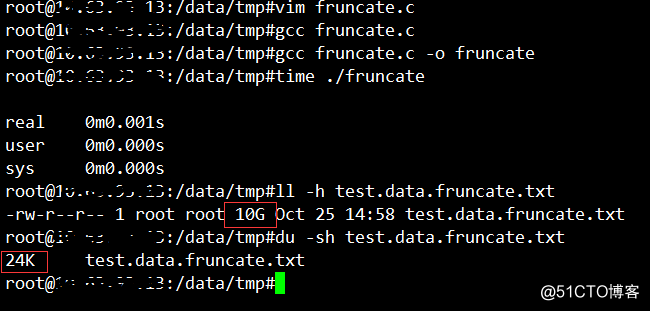标签:efi du -sh fse cto 方法 port 原来 roc 性能
一、课前预习写本篇文章的目的很简单,防止采坑、防止采坑、防止采坑
我们在开发程序的过程中,往往需要预分配磁盘空间,防止因磁盘空间不够而引发程序异常问题(已踩过坑), 现网查阅资料,有些预分配磁盘空间的方法不正确,在这里特别记录一下, 除此之外,把正确的预分配的方法和大家分享一下,如果其他人有建议,欢迎拍砖狠砸
#include <stdio.h>
#include <unistd.h>
#include <sys/types.h>
#include <sys/stat.h>
#include <fcntl.h>
#include <string.h>
#include <stdint.h>
uint64_t file_size = 10*1024*1024*1024ULL;
int main()
{
int fd = -1;
fd = open("test.data.fruncate.txt", O_RDWR | O_CREAT, 0666);
if(fd < 0){
printf("open failed\n");
return -1;
}
if(ftruncate(fd, file_size)){
printf("ftruncate error\n");
return -1;
}
lseek(fd, file_size - 1,SEEK_CUR);
write(fd, "1", 1);
close(fd);
return 0;
}测试结果
#include <stdio.h>
#include <unistd.h>
int main()
{
FILE *f = fopen("test.data", "w");
fseek(f, 256*1024*1024 - 1, SEEK_CUR);
fputc(0,f);
return 0;
} dd if=/dev/zero of=test bs=1M count=0 seek=1024测试结果
1 .ls显示文件的“逻辑上”的size, 这不是文件真正占用磁盘空间大小,这部分空间也会被其他进程使用。
2 .du显示文件“物理上”的size,即du显示的size是文件在硬盘上占据了多少个block计算出来的
请求tlinux内核大神后,原来还存在fallocate 和 posix_fallocate这样的函数, 还是自己太low, 其实fallocate 和 posix_fallocate两个最大的区别:
This is a nonportable, Linux-specific system call
废话也不多说, 还是直接上代码比较好一点, 一目了然
#define _GNU_SOURCE /* See feature_test_macros(7) */
#include <fcntl.h>
#include <stdio.h>
#include <sys/types.h>
#include <sys/stat.h>
#include <errno.h>
#include <string.h>
#include <stdint.h>
uint64_t file_size = 10*1024*1024*1024ULL;
//int fallocate(int fd, int mode, off_t offset, off_t len);
//int posix_fallocate(int fd, off_t offset, off_t len);
int main()
{
int fd = -1;
int ret = -1;
fd = open("tmp.txt", O_CREAT|O_RDWR, 0666);
if(fd < 0){
printf("fd < 0");
return -1;
}
//ret = fallocate(fd, 0, 0, file_size);
ret = posix_fallocate(fd, 0, file_size);
if(ret < 0 ){
printf("ret = %d, errno = %d, %s\n", ret, errno, strerror(errno));
return -1;
}
printf("fallocate create %.2fG file\n", file_size/1024/1024/1024.0);
close(fd);
return 0;
}
测试结果:
root@xxx.xxx.xxx.xxx:/data6#time ./posix_fallocate
fallocate create 10.00G file
real 0m0.014s
user 0m0.000s
sys 0m0.014s
root@xxx.xxx.xxx.xxx:/data6#ll -h posix_fallocate.file.txt
-rw-r--r-- 1 root root 10G Oct 25 15:45 posix_fallocate.file.txt
root@xxx.xxx.xxx.xxx:/data6#du -sh posix_fallocate.file.txt
11G posix_fallocate.file.txt

不仅可以占住空间,而且速度非常快, 之前有过一个愚蠢的想法, 用dd命令直接创建10G文件,但是会造成IO毛刺,肯定不能这么玩,要是创造100G文件岂不是凉凉了。dd命令还是安安静静压测下磁盘性能或者创造一些小文件比较好。
ret = -1, errno = 95, Operation not supportedroot@xxx.xxx.xxx.xxx:/data6#fallocate -l 10G 2.txt
root@xxx.xxx.xxx.xxx:/data6#ll -h 2.txt
-rw-r--r-- 1 root root 10G Oct 25 15:33 2.txt
root@xxx.xxx.xxx.xxx:/data6#du -sh 2.txt
11G 2.txt标签:efi du -sh fse cto 方法 port 原来 roc 性能
原文地址:http://blog.51cto.com/10114285/2311140